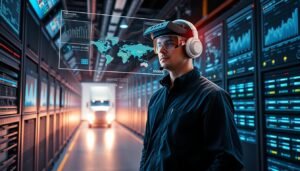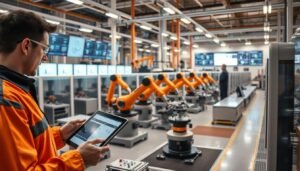AI and machine learning are transforming the way we live and work. From early experiments in the 1950s to today’s advanced algorithms, these technologies have come a long way. Big data, increased compute power, and breakthroughs in transformer models have fueled this evolution.
Generative AI tools like ChatGPT and Midjourney are prime examples of this progress. These systems are not just tools; they are reshaping industries. Healthcare, retail, and logistics are just a few sectors benefiting from these innovations. Improved infrastructure and algorithmic developments are driving this change.
Understanding how these technologies work is key. For instance, building machine learning models involves data preparation, model selection, and training. This process highlights the importance of precision and efficiency in creating intelligent systems.
Key Takeaways
- AI and machine learning are revolutionizing automation and intelligence.
- Big data and compute power are core components of this transformation.
- Generative AI tools like ChatGPT and Midjourney are leading examples.
- Industries like healthcare and retail are seeing significant impacts.
- Improved infrastructure and algorithms are driving innovation.
Introduction: The Rise of AI and Machine Learning
The journey of AI and machine learning began decades ago, evolving into a cornerstone of modern technology. From its early days in the 1950s to today’s sophisticated systems, these innovations have transformed how we approach complex tasks. This evolution has been fueled by advancements in compute power, big data, and algorithmic breakthroughs.

Understanding the Evolution from Past to Present
In the beginning, AI was limited to simple models that could handle basic tasks. Over time, these models grew more complex, enabling applications like digital assistants and recommendation systems. For example, tools like Siri and Netflix’s recommendation engine showcase the practical uses of these advancements.
According to a McKinsey report, 72% of organizations have adopted AI in some capacity. This widespread adoption highlights the growing reliance on these technologies across industries. From healthcare to retail, companies are leveraging AI to improve efficiency and decision-making.
Setting the Stage for Future Innovations
Today, companies are shifting their strategies to embrace AI-driven solutions. This trend is paving the way for further innovations in automation and intelligence. For instance, predictive analytics is helping businesses forecast trends and optimize operations.
Understanding these historical trends is crucial to appreciating the rapid transformations ahead. As AI continues to evolve, its applications will expand, reshaping industries and creating new opportunities. The future of automation and intelligence is built on the foundation of these past and present advancements.
Historical Context and Modern Developments
The roots of AI trace back to the 1950s, marking the start of a technological revolution. Early experiments focused on creating systems that could mimic human intelligence. These efforts laid the foundation for today’s advanced algorithms and intelligent tools.

Key Milestones from the 1950s to 2010s
In 1950, Alan Turing introduced the Turing Test, a benchmark for evaluating machine intelligence. This was followed by the development of SNARC in 1951, the first artificial neural network. These early steps demonstrated the potential of algorithmic approaches to solving complex problems.
By the 1960s, researchers began exploring more sophisticated models. The nearest neighbor algorithm, developed in 1967, was a breakthrough in pattern recognition. This paved the way for advancements in language processing and other applications.
The 1990s saw significant progress with IBM’s Deep Blue defeating chess champion Garry Kasparov in 1997. This event highlighted the power of technology in mastering strategic games. The 2010s brought further innovations, such as Geoffrey Hinton’s deep CNN architecture winning the ImageNet challenge in 2012.
These milestones illustrate how algorithmic advancements have shaped the field. From early neural networks to modern deep learning models, each breakthrough has contributed to the evolution of intelligent systems.
Transformative Effects on Technology
Historical developments have had a profound impact on modern technology. For example, the introduction of backpropagation in the 1970s enabled the training of deep neural networks. This innovation remains a cornerstone of AI research today.
Similarly, the rise of natural language processing has transformed how we interact with machines. Tools like ChatGPT are a testament to the progress made in language understanding. These advancements continue to drive innovation across industries.
| Year | Milestone | Impact |
|---|---|---|
| 1950 | Turing Test | Set a benchmark for machine intelligence |
| 1951 | SNARC | First artificial neural network |
| 1997 | Deep Blue | Defeated chess champion Garry Kasparov |
| 2012 | Deep CNN | Won ImageNet challenge |
These examples show how historical milestones have shaped the field. By understanding these developments, we can better appreciate the transformative power of technology.
Key Trends in Machine Learning and AI Innovation
Innovations in AI are reshaping industries and creating new opportunities. From creative tools to industrial applications, these technologies are transforming the way we work and interact. Let’s explore the latest trends driving this evolution.
Generative AI and Its Expanding Applications
Generative AI tools like ChatGPT and Midjourney are opening new avenues across creative and business fields. These systems can produce text, images, and even music, enabling unique applications in marketing, design, and entertainment. For example, Goldman Sachs reported a 20% increase in developer productivity attributed to generative AI.
In healthcare, these tools are being used to generate synthetic data for research and training. This reduces reliance on sensitive patient information while accelerating development in the field. The versatility of generative AI makes it a game-changer for multiple industries.
Advancements in Natural Language Processing and Computer Vision
Natural language processing (NLP) has seen significant breakthroughs, empowering conversational interfaces and contextual understanding. Models like Google’s LaMDA and OpenAI’s GPT-3 can hold nuanced conversations and translate languages with remarkable accuracy. These advancements are transforming customer service, education, and more.
Computer vision is another area making waves. From security systems to quality control in manufacturing, this technology is enhancing efficiency and accuracy. For instance, Siemens uses edge-based models for predictive maintenance in factories, reducing downtime and costs.
Improvements in Infrastructure and Algorithmic Developments
Enhanced GPU capabilities and cloud computing are supporting the growth of AI. These infrastructural improvements enable faster processing and scalability, making advanced tools accessible to more organizations. According to a recent survey, 68% of IT leaders plan to invest in AI within six months.
Algorithmic developments are also driving progress. Research breakthroughs are making AI more efficient and accessible across fields. For example, AutoML is being adopted by 61% of decision-makers, simplifying the creation of custom models.
These trends collectively point toward a future where AI seamlessly integrates into everyday processes. From creative tools to industrial applications, the possibilities are endless.
Exploring the Future of Machine Learning in Industry
The rapid evolution of data-driven technologies is reshaping industries and enabling smarter decision-making. Enterprises are leveraging advanced models to optimize operations and drive innovation. This progress is fueled by two key factors: the growth of big data and cost-effective compute power.
Big Data and Compute Power as Enabling Factors
Big data serves as the backbone of modern systems. With businesses generating 2.5 quintillion bytes of data daily, the need for efficient processing is critical. Enhanced GPU capabilities and cloud ecosystems have made it easier to handle this volume.
For example, General Electric reported a 20% reduction in unplanned downtime using predictive maintenance models. This highlights how compute power and data analysis work together to improve efficiency.
The Role of MLOps in Enterprise Adoption
MLOps practices are streamlining the integration of intelligent systems into existing workflows. Companies investing in MLOps have seen a 35% increase in deployment efficiency, according to Deloitte.
In finance, AI has reduced false positives in fraud detection by 50%. These examples show how MLOps ensures seamless adoption and scalability.
| Factor | Impact | Example |
|---|---|---|
| Big Data | Enables advanced predictive modeling | Healthcare research using synthetic data |
| Compute Power | Boosts processing speed and scalability | Cloud-based solutions for manufacturing |
| MLOps | Streamlines deployment and integration | Fraud detection in banking |
These advancements are transforming industries by enabling smarter decisions and efficient training. As research continues, the potential for innovation grows, making this an exciting time for technology.
Impact on Sectors: Healthcare, Retail, and Manufacturing
AI-driven solutions are revolutionizing key sectors like healthcare, retail, and manufacturing. These technologies are enhancing efficiency, personalization, and decision-making across industries. From early disease detection to tailored customer experiences, the applications are vast and impactful.
Enhancing Diagnostics and Personalized Treatment in Healthcare
In healthcare, AI is transforming diagnostics and treatment. Tools like Google’s DeepMind can detect diseases such as breast cancer with remarkable accuracy. These systems analyze medical images to identify patterns that might be missed by human eyes.
Personalized treatment is another breakthrough. IBM’s Watson uses natural language processing to analyze patient data and recommend tailored therapies. This approach improves outcomes and reduces trial-and-error in treatment plans.
Clinical decision support systems are also benefiting. Hospitals using AI report a 20% increase in patient satisfaction. These tools help doctors make faster, more informed decisions, saving time and lives.
Automation and Customization in Manufacturing
Manufacturing is seeing significant advancements through automation. Sophisticated models are improving quality control, reducing defects, and cutting costs. For example, edge-based systems are used for predictive maintenance, minimizing downtime.
Customization at scale is another key benefit. Manufacturers can now produce personalized products quickly and cost-effectively. This flexibility meets consumer demands while maintaining efficiency.
AI-powered robots are also streamlining operations. From assembly lines to packaging, these tools enhance productivity and precision. This shift allows human workers to focus on more complex tasks.
Personalized Customer Experiences in Retail
Retail businesses are leveraging AI to create tailored customer experiences. Amazon’s recommendation engine is a prime example. It analyzes purchase history to suggest products, boosting sales and customer satisfaction.
Inventory management is another area seeing improvements. AI tools predict demand, ensuring optimal stock levels. This reduces waste and ensures popular items are always available.
Chatbots powered by natural language processing are enhancing customer service. These tools handle inquiries efficiently, freeing up staff for more critical tasks. As a result, businesses can provide faster, more personalized support.
AI is reshaping industries by improving efficiency and personalization. From healthcare to retail, these technologies are driving innovation and creating new opportunities. To learn more about the latest trends, explore AI and machine learning trends.
Technological Advancements Driving Automation and Intelligence
Breakthroughs in computer vision and NLP are reshaping how businesses interact with customers and streamline processes. These technologies are not just tools; they are transforming industries by automating complex tasks and enhancing resource allocation efficiency. From security systems to customer service, the applications are vast and impactful.
Computer Vision: From Image Recognition to Advanced Applications
Computer vision has evolved from basic image recognition to sophisticated applications in security and manufacturing. For example, facial recognition systems are now used in airports and retail stores to enhance security and personalize customer experiences. These systems rely on convolutional neural networks (CNNs) to analyze visual data with remarkable accuracy.
In manufacturing, computer vision is improving quality control. Edge-based models can detect defects in real-time, reducing waste and ensuring high-quality products. This technology is also being used for predictive maintenance, minimizing downtime and optimizing resource use.
NLP Transformations in Conversational AI
Natural language processing (NLP) has made conversational AI more robust and context-aware. Tools like ChatGPT and Google’s LaMDA can hold nuanced conversations, making them invaluable for customer service. These systems analyze customer queries and provide accurate responses, improving satisfaction and efficiency.
Enterprise chatbots powered by NLP are transforming how businesses interact with customers. For instance, chatbots can handle inquiries, process orders, and even provide personalized recommendations. This automation frees up human resources for more complex tasks, enhancing overall productivity.
These advancements are meeting critical business needs by automating processes and improving customer interactions. As industries continue to integrate these technologies, the potential for innovation grows, making this an exciting time for automation and intelligence.
Challenges and Ethical Considerations in AI Adoption
As AI continues to advance, ethical considerations and challenges are becoming increasingly critical. While these technologies offer immense potential, they also raise concerns about privacy, bias, and environmental impact. Addressing these issues is essential for responsible and sustainable development.
Security, Data Privacy, and Algorithmic Bias
One of the most pressing concerns is data privacy. AI systems rely on vast amounts of personal data for training, raising questions about how this information is collected, stored, and used. High-profile cases have highlighted the risks of data breaches and misuse, underscoring the need for robust security measures.
Algorithmic bias is another significant issue. Historical data used to train AI models can perpetuate and amplify biases in areas like hiring, lending, and criminal justice. For example, some systems have been found to discriminate against certain ethnic groups, leading to calls for greater accountability and transparency.
To mitigate these risks, organizations must adopt best practices such as regular audits, diverse datasets, and ethical guidelines. The White House has already invested $140 million to address these challenges, signaling the importance of ethical AI development.
Technical Integration with Legacy Systems and Environmental Impacts
Integrating modern AI solutions into legacy systems is a major hurdle for many companies. Outdated software and infrastructure can limit the effectiveness of AI, making it essential to modernize tech stacks. This process requires significant investment but is crucial for seamless adoption.
Environmental concerns are also growing. The training and deployment of large-scale AI models consume substantial energy, contributing to carbon emissions. For instance, training a single model can generate as much CO2 as five cars over their lifetimes. Companies must explore energy-efficient alternatives and sustainable practices to reduce their environmental footprint.
| Challenge | Impact | Solution |
|---|---|---|
| Data Privacy | Risk of breaches and misuse | Implement robust security measures |
| Algorithmic Bias | Discrimination in hiring and lending | Use diverse datasets and regular audits |
| Legacy Systems | Limits AI effectiveness | Modernize tech infrastructure |
| Environmental Impact | High energy consumption | Adopt energy-efficient practices |
Balancing innovation with ethical standards is key to the responsible adoption of AI. By addressing these challenges, we can ensure that these technologies benefit society while minimizing risks. For more insights, explore AI and machine learning trends.
Conclusion
The evolution of intelligent systems has reshaped industries and redefined possibilities. From early breakthroughs to modern advancements, these technologies have created new patterns of innovation. Industries like healthcare, retail, and manufacturing are witnessing transformative impacts, driven by smarter input and efficient practices.
Historical milestones, such as the development of neural networks and generative tools, have paved the way for current trends. These advancements highlight the importance of collaboration within teams to achieve meaningful progress. Ethical considerations, including data privacy and bias, remain critical as we integrate these systems responsibly.
To stay ahead, it’s essential to adopt best practices and remain informed about emerging trends. By fostering a culture of innovation and teamwork, we can unlock the full potential of these technologies. The journey continues, and the possibilities are endless.
FAQ
What is the role of AI in modern industries?
AI plays a crucial role in industries by automating tasks, improving decision-making, and enhancing efficiency. It’s widely used in healthcare, retail, and manufacturing to drive innovation and productivity.
How has natural language processing evolved over time?
Natural language processing (NLP) has advanced significantly, enabling systems like Google Assistant and ChatGPT to understand and generate human-like text. This evolution has transformed conversational AI and customer service applications.
What are the key challenges in adopting AI technologies?
Challenges include ensuring data privacy, addressing algorithmic bias, and integrating AI with legacy systems. Companies also need to consider environmental impacts and resource usage.
How is AI transforming healthcare?
AI is revolutionizing healthcare by improving diagnostics, enabling personalized treatment plans, and streamlining administrative tasks. Tools like image recognition and predictive analytics are enhancing patient care.
What is the significance of MLOps in enterprise AI adoption?
MLOps, or machine learning operations, helps businesses manage and scale AI models efficiently. It ensures seamless integration, monitoring, and optimization of AI systems in real-world applications.
How does computer vision impact industries today?
Computer vision is used in various applications, from facial recognition to quality control in manufacturing. It enables machines to interpret and analyze visual data, driving automation and accuracy.
What are the ethical considerations in AI development?
Ethical considerations include ensuring fairness, transparency, and accountability in AI systems. Developers must address biases, protect user privacy, and minimize environmental impacts.
How can businesses leverage AI for customer experiences?
Businesses use AI to personalize customer interactions, analyze behavior, and provide tailored recommendations. Tools like chatbots and predictive analytics enhance engagement and satisfaction.
What advancements are shaping the future of AI?
Key advancements include generative AI, improved NLP, and enhanced infrastructure. These innovations are expanding AI’s capabilities and applications across industries.
Why is data privacy critical in AI systems?
Data privacy is essential to protect user information and maintain trust. AI systems must comply with regulations and implement robust security measures to safeguard sensitive data.





















